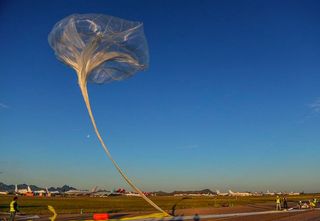World View Makes 1st Commercial Balloon Flight to Near Space

A company that plans to send tourists to near-space by balloon has just completed its first commercial flight.
The Arizona-based company World View lofted two payloads during an umanned balloon flight Sunday (March 8) from southeastern Arizona. The mission was part of NASA's Space Technology Mission Directorate's Flight Opportunities Program, which flies experiments designed by students, educators and researchers.
"World View is committed to furthering stratospheric exploration and research," Taber MacCallum, World View's chief technology officer, said in a statement. "Our first flight as a NASA flight service provider marks the launch of our commercial efforts to aid research and education by providing a new way for NASA and others to access near-space."
One of the experiments measured the properties of cosmic rays, which are believed to emanate from supernova explosions. The payload was developed by 18 undergraduate students and three faculty members at Gannon University in Pennsylvania.
The second experiment, known as the Planetary Atmospheres Minor Species Sensor, is designed to measure the distribution of gases in the air of Earth and other worlds. It was designed by students from the Florida Space Institute at the University of Central Florida.
"Many types of space applications and research need more access to near-space than has been possible previously," World View chief scientist Alan Stern, who is also principal investigator of NASA's Pluto-bound New Horizons mission, said in the same statement..
"With this flight," Stern added, "World View illustrates its ability to provide expanded access to the near-space environment for NASA, private corporations and universities."
Get the Space.com Newsletter
Breaking space news, the latest updates on rocket launches, skywatching events and more!
In February, Arizona-based World View announced it had broken the world altitude record for a parafoil flight. The altitude of 102,200 feet (31,151 meters) is the same that officials hope to reach when they loft passengers, officials added.
World View's passenger flights would cost $75,000 per person and would soar high enough for passengers to see black sky and the curvature of the Earth. Last year, the organization said it plans to offer these flights starting in 2016.
Follow Elizabeth Howell @howellspace, or Space.com @Spacedotcom. We're also on Facebook and Google+. Originally published on Space.com.
Join our Space Forums to keep talking space on the latest missions, night sky and more! And if you have a news tip, correction or comment, let us know at: community@space.com.

Elizabeth Howell (she/her), Ph.D., is a staff writer in the spaceflight channel since 2022 covering diversity, education and gaming as well. She was contributing writer for Space.com for 10 years before joining full-time. Elizabeth's reporting includes multiple exclusives with the White House and Office of the Vice-President of the United States, an exclusive conversation with aspiring space tourist (and NSYNC bassist) Lance Bass, speaking several times with the International Space Station, witnessing five human spaceflight launches on two continents, flying parabolic, working inside a spacesuit, and participating in a simulated Mars mission. Her latest book, "Why Am I Taller?", is co-written with astronaut Dave Williams. Elizabeth holds a Ph.D. and M.Sc. in Space Studies from the University of North Dakota, a Bachelor of Journalism from Canada's Carleton University and a Bachelor of History from Canada's Athabasca University. Elizabeth is also a post-secondary instructor in communications and science at several institutions since 2015; her experience includes developing and teaching an astronomy course at Canada's Algonquin College (with Indigenous content as well) to more than 1,000 students since 2020. Elizabeth first got interested in space after watching the movie Apollo 13 in 1996, and still wants to be an astronaut someday. Mastodon: https://qoto.org/@howellspace
Most Popular


